Sprained Ankle (Lateral Ligament)
Updated:
(Also known as Ankle Sprain, Rolled Ankle, Lateral Ligament Sprain of the Ankle, Twisted Ankle)
N.B. The term ‘sprained ankle’ will be used in this document to describe the injury known as a lateral ligament sprain of the ankle.

What is a sprained ankle?
A sprained ankle is a condition characterized by damage and tearing to the soft tissue and ligaments of the ankle. The most commonly affected ligament in this condition is the lateral ligament (figure 1).
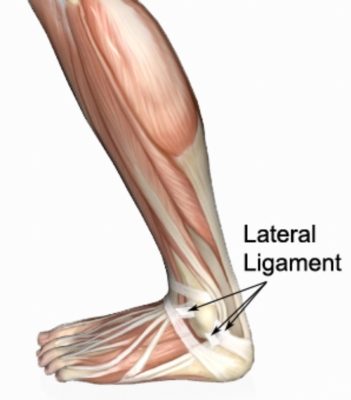
A ligament is a strong band of connective tissue which attaches bone to bone. The lateral ligament of the ankle comprises of three bands of connective tissue (figure 1) and is responsible for joining the fibula to the talus and calcaneus (figure 2).
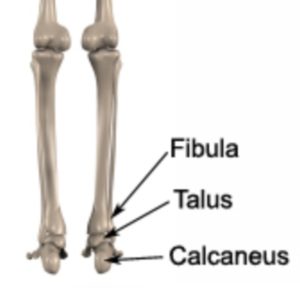
Collectively, the lateral ligament acts to prevent the foot and ankle from turning inward excessively (inversion – figure 3). When this movement is excessive and beyond what the ligament can withstand, tearing to the ligament occurs. This condition is known as a sprained ankle and may range from a small partial tear resulting in minimal pain, to a complete rupture resulting in significant pain and disability.
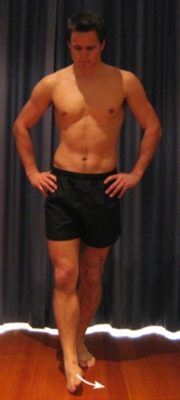
Ankle sprains range in severity from grade 1 to grade 3 and are classified as follows:
- Grade 1 Sprain: a small number of ligament fibres are torn resulting in some pain, but allowing full function.
- Grade 2 Sprain: a significant number of ligament fibres are torn with moderate loss of function and some degree of joint instability.
- Grade 3 Sprain: all lateral ligament fibres are ruptured resulting in major loss of function and significant joint instability.
The majority of ankle sprains are grade 2.
Causes of a sprained ankle
An ankle sprain commonly occurs during activities involving jumping and landing, or, activities requiring rapid changes in direction, especially on uneven surfaces. They often occur in basketball, football, volleyball and netball. The usual mechanism of injury is an extreme combination of turning the foot inwards (inversion – figure 3) and pointing the foot and ankle downwards (plantarflexion – figure 4) during weight bearing. Sometimes the player may land awkwardly from a high jump and roll the ankle, or, more commonly, the player may land on an opposition player’s foot resulting in the foot and ankle turning inwards excessively with subsequent injury to the lateral ligament. In patients who experience recurrent ankle sprains there is often a loss of joint stability resulting in the patient rolling their ankle on flat surfaces or during trivial activities.
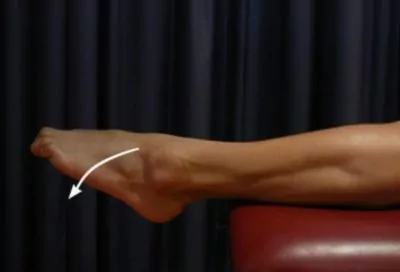
Signs and symptoms of a sprained ankle
Patients with this condition may notice an audible snap, click or tearing sound at the time of injury, with subsequent pain and possible swelling (figure 5) at the outside of the ankle. In minor cases of a sprained ankle, patients may be able to continue activity only to experience an increase in pain, swelling and stiffness in the ankle after activity with rest (particularly first thing in the morning).
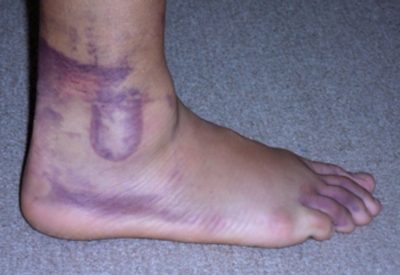
In more severe cases, pain may be severe at the time of injury, and a rapid onset of swelling may be present (within the first few hours following injury) at the outside of the ankle (figure 5). The patient may also walk with a limp or be unable to weight bear due to pain and may develop bruising (figure 5) and stiffness over the coming days.
Patients with this condition typically experience tenderness on firmly touching the outer aspect of the ankle as well as an increase in pain with certain movements that place the lateral ligaments on stretch (such as turning the foot inwards – inversion (figure 3) particularly when combined with pointing the foot and ankle downwards – plantarflexion (figure 4).
Diagnosis of a sprained ankle
A thorough subjective and objective examination from a physiotherapist is usually sufficient to diagnose a sprained ankle. Investigations such as an X-ray, ultrasound, MRI or CT scan are often required to confirm diagnosis and rule out other injuries (particularly fractures).
Treatment for a sprained ankle

Members Only ContentBecome a PhysioAdvisor Member to gain full access to this exclusive content. For more details see Become a Member. Already a member? Login Now
-
 Premium Strapping Tape 38mm (Victor)$16.00 – $295.00
Premium Strapping Tape 38mm (Victor)$16.00 – $295.00 -
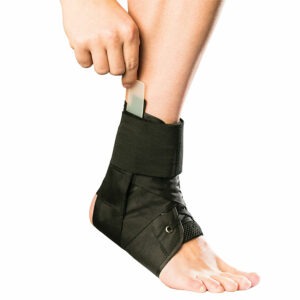 AllCare Ortho Total Ankle Brace (AOA19)$55.00
AllCare Ortho Total Ankle Brace (AOA19)$55.00 -
 AllCare Instant Cold Pack (15 x 25cm)$15.00
AllCare Instant Cold Pack (15 x 25cm)$15.00 -
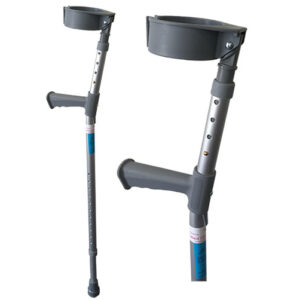 Forearm Crutches Adjustable – Standard Grip$59.00
Forearm Crutches Adjustable – Standard Grip$59.00
Prognosis of a sprained ankle
In cases of a minor to moderate sprained ankle (grades I and II), return to sport or normal activity can usually occur in 2 – 6 weeks with appropriate management and treatment. Patients with a more severe injury (e.g. a complete rupture – grade III) will require a longer period of rehabilitation to gain optimum function.
Contributing factors to the development of a sprained ankle
Although a large number of ankle sprains are unavoidable, there are some factors which can increase a patients likelihood of experiencing an ankle sprain or suffering a recurrence. These factors need to be assessed and corrected with direction from a physiotherapist. Some of these may include:
- poor proprioception or balance
- inadequate rehabilitation following a previous ankle sprain
- joint instability
- muscle weakness
- poor core stability or a lack of co-ordination
- joint stiffness
- poor muscle flexibility
- inadequate warm up
- inappropriate training
- inappropriate training surfaces
- poor biomechanics or foot posture
- decreased fitness or sport specific conditioning
- fatigue
- inappropriate footwear
Physiotherapy for a sprained ankle
Physiotherapy treatment is essential for all patients with a sprained ankle as inadequate rehabilitation can result in a poor outcome with a high likelihood of re-injury. Physiotherapy can hasten the healing process, ensure an optimal outcome and reduce the likelihood of recurrence. Treatment may comprise:
- soft tissue massage
- joint mobilization
- dry needling
- electrotherapy (e.g. ultrasound)
- anti-inflammatory advice
- the use of crutches
- the use of heel wedges
- ankle taping
- ankle bracing
- ice or heat treatment
- exercises to improve flexibility, strength and balance
- hydrotherapy
- education
- activity modification advice
- biomechanical correction
- a gradual return to activity program
- footwear advice
- the prescription of orthotics
Other intervention for a sprained ankle
Despite appropriate physiotherapy management, a small percentage of patients with this condition do not improve adequately. When this occurs the treating physiotherapist or doctor can advise on the best course of management. This may involve further investigation such as an X-ray, ultrasound, CT scan or MRI, pharmaceutical intervention, corticosteroid injection or a review by a specialist who can advise on any procedures that may be appropriate to improve the condition. Surgical reconstruction of the lateral ligament of the ankle is occasionally required when all conservative measures fail and / or when re-injury continues to occur again and again due to ankle instability.
Exercises for a sprained ankle
The following exercises are commonly prescribed to patients with this condition. You should discuss the suitability of these exercises with your physiotherapist prior to beginning them. Generally, they should be performed 3 times daily and only provided they do not cause or increase symptoms.
Your physiotherapist can advise when it is appropriate to begin the initial exercises and eventually progress to the intermediate and advanced exercises. As a general rule, addition of exercises or progression to more advanced exercises should take place provided there is no increase in symptoms.
Initial Exercises
Foot and Ankle Up and Down
Slowly move your foot and ankle up and down as far as possible and comfortable without pain (figure 6). Aim for no more than a mild to moderate stretch. Repeat 10 – 20 times provided there is no increase in symptoms.
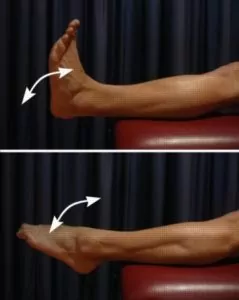
Ankle Stretch with Towel
Begin this ankle stretch in long sitting with your leg to be stretched in front of you. Your knee and back should be straight and a towel or rigid band placed around your foot as demonstrated (figure 7). Using your foot, ankle and the towel, slowly bring your toes towards your head until you feel a stretch in the back of your ankle, calf or leg. Hold for 5 seconds and repeat 10 times at a mild to moderate stretch provided the exercise is pain free.
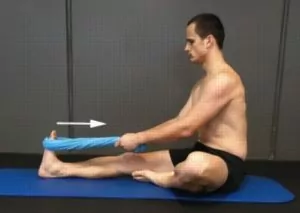
Foot and Ankle In and Out
Slowly move your foot and ankle in and out as far as possible and comfortable without pain (figure 8). Aim for no more than a mild to moderate stretch. Repeat 10 – 20 times provided there is no increase in symptoms.
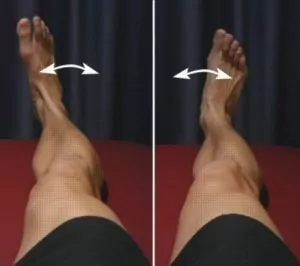
Intermediate Exercises

Members Only ContentBecome a PhysioAdvisor Member to gain full access to this exclusive content. For more details see Become a Member. Already a member? Login Now
Advanced Exercises

Members Only ContentBecome a PhysioAdvisor Member to gain full access to this exclusive content. For more details see Become a Member. Already a member? Login Now
Rehabilitation Protocol for a sprained ankle

Members Only ContentBecome a PhysioAdvisor Member to gain full access to this exclusive content. For more details see Become a Member. Already a member? Login Now
 Find a Physio
Find a Physio
Find a physiotherapist in your local area to treat an ankle sprain.
 Physiotherapy products for a sprained ankle
Physiotherapy products for a sprained ankle
Some of the most commonly recommended products by physiotherapists to hasten healing and speed recovery in patients with this condition include:
-
 AllCare Ortho Total Ankle Brace (AOA19)
AllCare Ortho Total Ankle Brace (AOA19) -
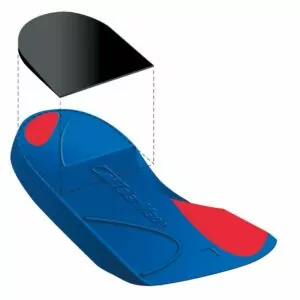 Heel Lifts (Elevators – Talar Made) (Pack of 5 Pairs)
Heel Lifts (Elevators – Talar Made) (Pack of 5 Pairs) -
 Forearm Crutches Adjustable – Standard Grip
Forearm Crutches Adjustable – Standard Grip -
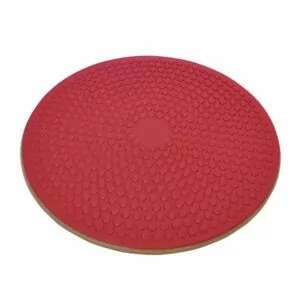 AllCare Wobble Board (Red – ACWOBRD)
AllCare Wobble Board (Red – ACWOBRD) -
 AllCare Band
AllCare Band -
 Premium Strapping Tape 38mm (Victor)
Premium Strapping Tape 38mm (Victor) -
 AllCare Tubing
AllCare Tubing -
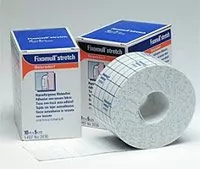 Fixomull Stretch 5cm x 10m
Fixomull Stretch 5cm x 10m -
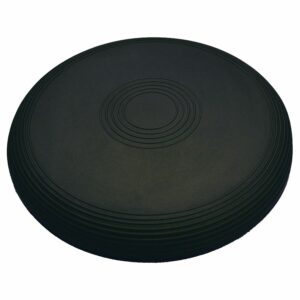 Lournet Stability Dura Disc
Lournet Stability Dura Disc -
 Tubigrip
Tubigrip -
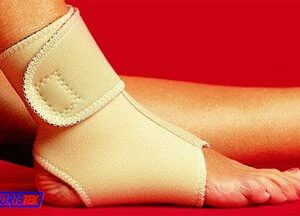 Thermoskin Heat Retaining Ankle Wrap
Thermoskin Heat Retaining Ankle Wrap
To purchase physiotherapy products for an ankle sprain, click on one of the above links or visit the PhysioAdvisor Shop.
 More information
More information
- Ankle Stretches.
- Ankle Strengthening Exercises.
- Balance Exercises.
- How to use Crutches
- Ice or Heat
- R.I.C.E. Regime.
- Return to Running Program.
- Return to Sport
- Ankle Taping.
- Why is my injury not improving?
- Ankle Diagnosis Guide.
Become a PhysioAdvisor Member
-
 Individual Membership (12 Months)$59.95 for 1 year
Individual Membership (12 Months)$59.95 for 1 year -
 Individual Membership (3 Months)$39.95 for 3 months
Individual Membership (3 Months)$39.95 for 3 months -
 Individual Membership (Yearly)$49.95 / year
Individual Membership (Yearly)$49.95 / year -
 Individual Membership (Monthly)$15.95 / month
Individual Membership (Monthly)$15.95 / month

Link to this Page
If you would like to link to this article on your website, simply copy the code below and add it to your page:
<a href="https://physioadvisor.com.au/injuries/ankle/sprained-ankle-lateral-ligament”>Sprained Ankle (Lateral Ligament) – PhysioAdvisor.com</a><br/>Get detailed information on a sprained ankle - causes, signs and symptoms, diagnosis, treatment, exercises, rehabilitation protocol, physiotherapy products and more.
Return to the top of Sprained Ankle (Lateral Ligament).
